3 Effective Apple Search Ads Automation Strategies
 Lina Danilchik
Lina Danilchik  Lina Danilchik
Lina Danilchik It comes as no surprise that both in brick-and-mortar stores and on the app stores, customers tend to behave differently on Mondays and Fridays, on workdays and on holidays. So, when running your Apple Search Ads (ASA), you should take into account these differences and constantly tweak your campaigns to make sure they are as efficient as possible at each time point.
You can say that you have a lot on your plate, while constant monitoring and tweaking Apple Search Ads takes loads of time. That’s true but, fortunately, there are tools that automatically increase and decrease bids, pause and enable keywords depending on the conditions you specify.
In this post, we will look into the most effective Apple Search Ads strategies for managing bids through custom rules and actionable tips that will enable you to automate your campaign and bid management.
The first one is the Tunnel Strategy. To implement this strategy, you need to have historical data and understand how much target actions for your app or mobile game should ideally cost.
Start with defining spend wasters, top converters and bid caps. Decide what your target cost per goal is. You should basically have four values specified: the desired minimum and maximum cost per action (CPA), and upper & lower bid values.
After that you will be able to form a “tunnel” where the ceiling is the maximum cost per goal (CPA) and bid cap, while the floor is the minimal CPA and lower bid limit. Your bid will move up and down within the boundaries of this tunnel.
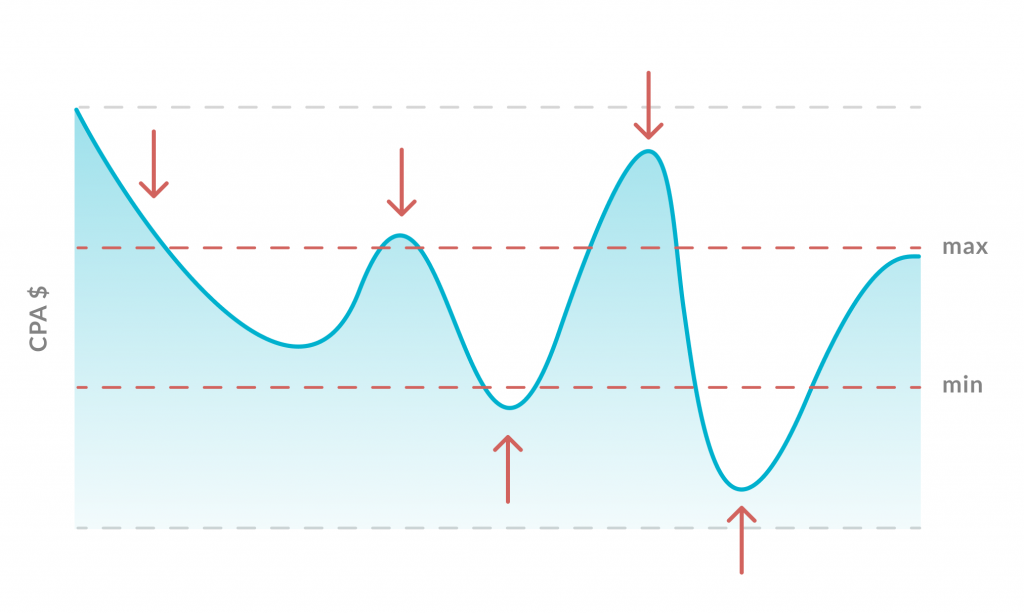
By sticking to this strategy, you will be able to get more downloads whilst reducing the cost per action (as a rule, cost per install or in-app purchase).
You can implement the tunnel strategy with the help of SearchAdsHQ, a platform for ASA campaign management & optimization and concurrently Apple Search Ads Partner. On this platform, you can create rules that automatically change bids according to the conditions you’ve specified, and manage CPA values that go beyond the tunnel.
Before we move on to some examples, let’s agree that when specifying the cost per goal value, we will save some space for minor differences. What does it mean? For example, we decide that the ideal cost per action is $20. However, if it fluctuates within the range of ±5%, it won’t be bad either. So, the cost per action values in the range of $19 to $21 are optimal.
Let’s consider an example of a rule for getting more installs with the minimum cost.
If our target cost per goal is lower than the tunnel’s floor – $19 – you can increase bids and win Apple Search Ads auctions. To automatically increase the bid by $0.5 if the cost per goal is less than $19, create the following rule in SearchAdsHQ:
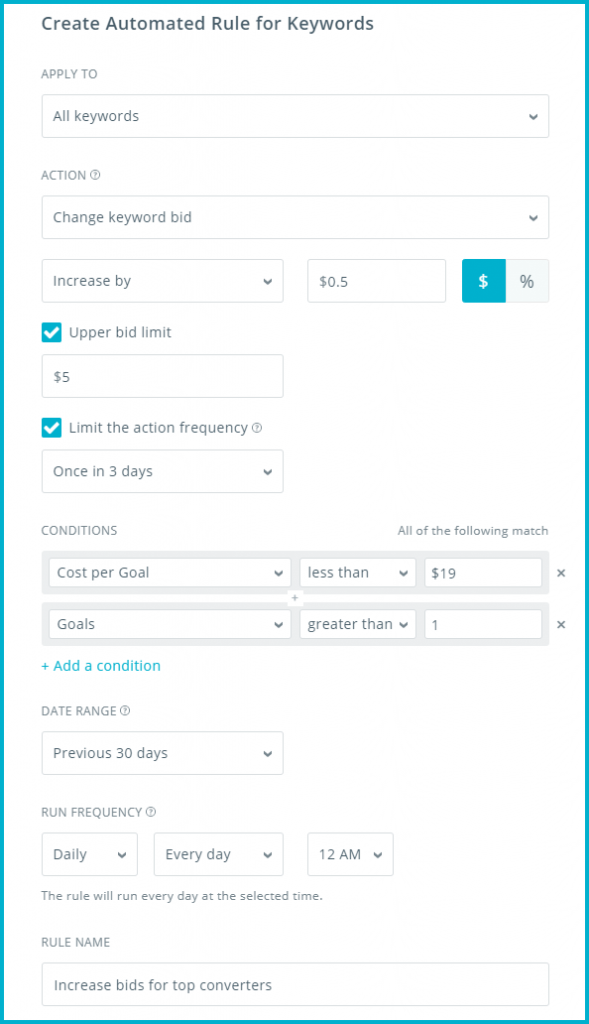
Note that we specify the upper bid limit (part of the tunnel’s ceiling) to avoid paying too much and exceeding the budget. Also note that we limit the action frequency, since once the bid is changed we will need some time to see changes in the funnel. That’s why if we don’t limit the action frequency, the bid will be constantly changed (in this case, increased) unnecessarily.
Specifying run frequency enables us to run a rule often and regularly, once a week or, even better, once a day. So, by filling in fields related to the action and run frequency, you can set a rule to run often but change the bid only when it’s appropriate. Action frequency depends on an app and the user journey. Once in 3 or 7 days are the most popular options.
You might have a reasonable question: why does the number of goals have to be greater than one? What if there is only one goal?
Well, if enough time has passed and there is no or only one goal, you should consider whether it makes sense to run ads for a keyword with such performance. To keep keywords of this kind under review, create the following rule and start receiving notifications on them:
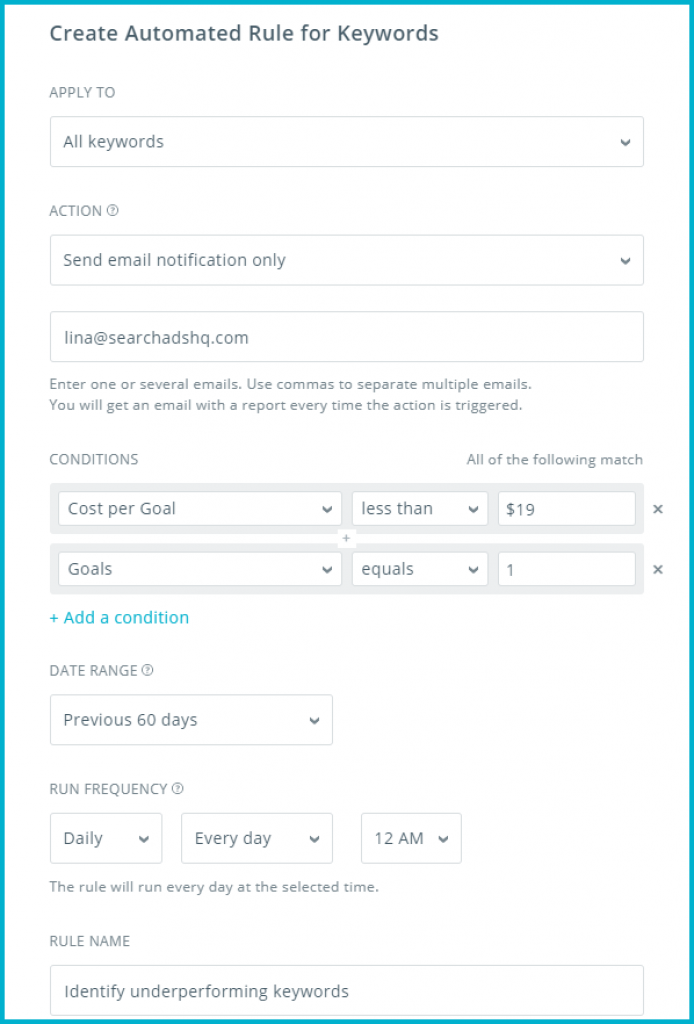
And here is a complementary example illustrating the tunnel strategy. We’ve already created a rule to make sure the bid will be increased if the cost per goal is lower than our tunnel’s floor. To implement the tunnel strategy, now it’s time to ensure that in cases when the cost per goal breaks through the ceiling of the tunnel, the costs will be automatically limited. You can easily do that with the following rule.
Let’s say the lower bid limit (the part of the tunnel’s floor) is $1. In general, when specifying bid limits, you can rely on Apple Search Ads benchmarks for your industry.
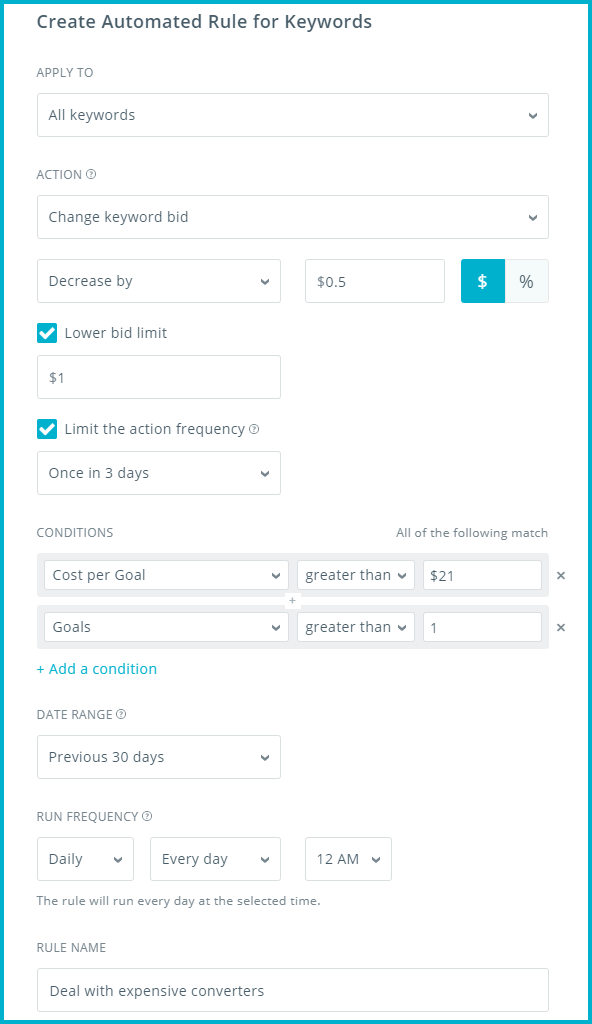
You can also increase or decrease bids by a relative value, for example, 5%
Since the user journey in mobile games is not the same as in apps, mobile game publishers are guided by the ROAS (return on ad spend) value. This indicator is often checked on the 7th day, by which an in-app purchase or another event should happen.
To make sure your advertising investments pay off, set up the following rule in SearchAdsHQ:
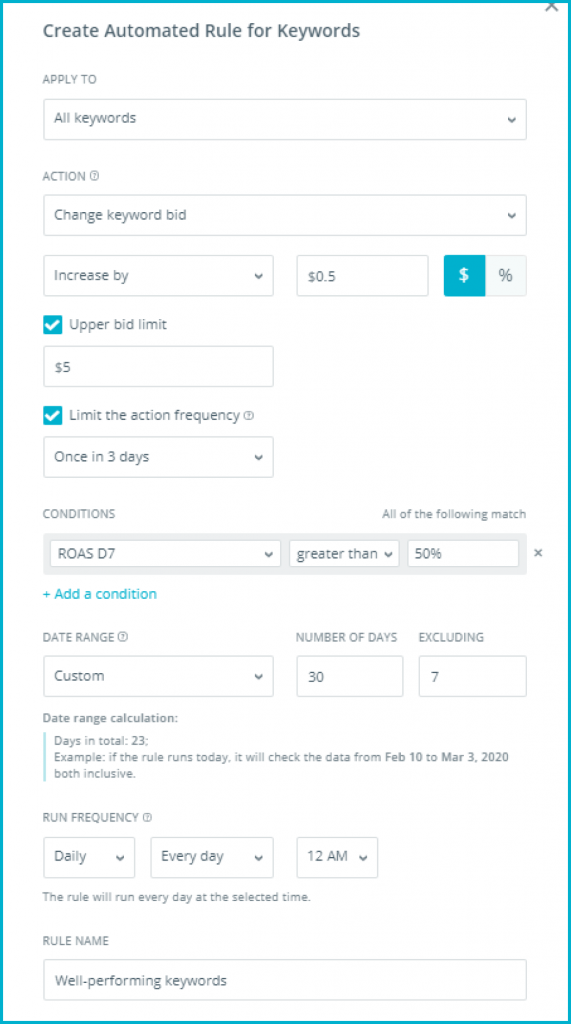
Note how we specify the date range: the rule will analyze the past month excluding the last 7 days to form a fully matured cohort.
If ROAS for some keywords does not meet your expectations, you can automatically decrease bids for them:
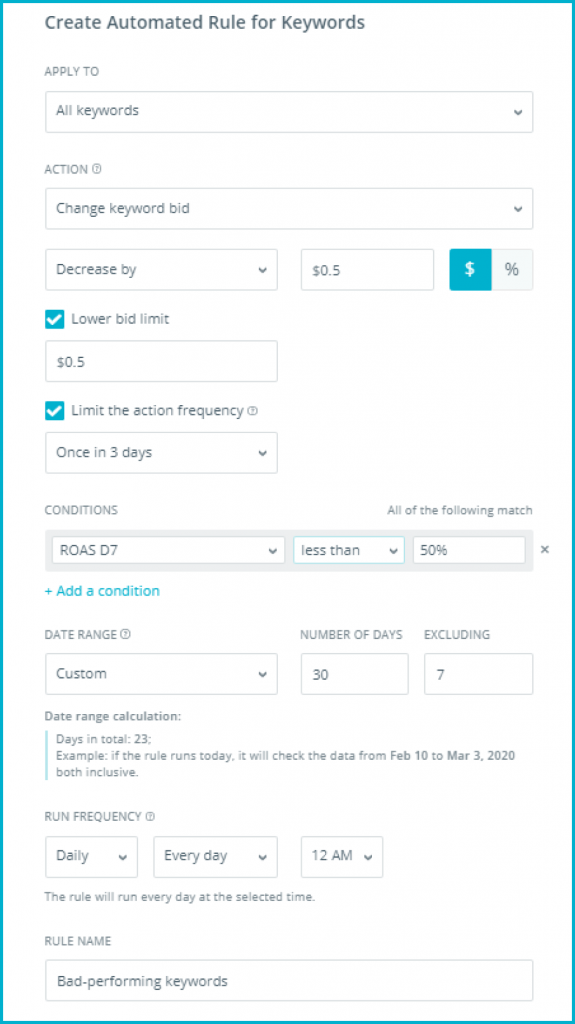
Now let’s move on to the next Apple Search Ads automation strategy – the Funnel Strategy.
As with the tunnel strategy, to implement the Funnel Strategy, you need to have enough historical data to build on. That will help you figure out your target cost per goal and optimum spend.
Funnel strategy is called this way due to similarity to a conversion funnel:
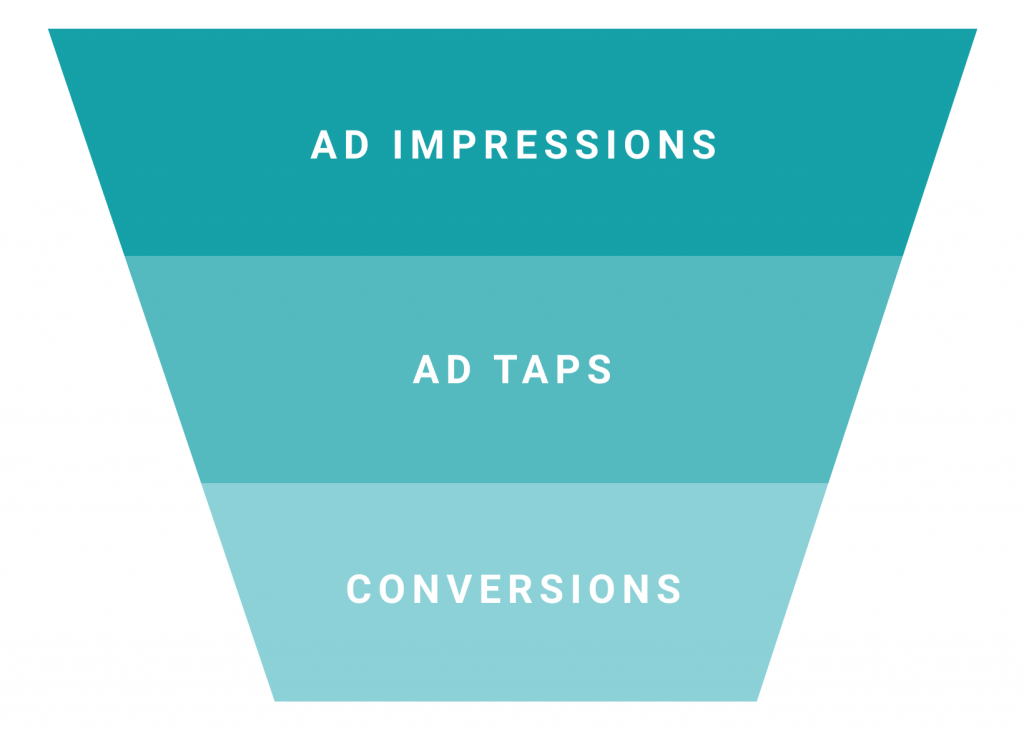
So, what is the essence of the funnel automation strategy? If you understand the user journey in your app, this strategy allows you to track early events in the funnel and predict keyword performance based on data.
For example, if you are focused on tracking the subscription cost, you may miss out on changes in the auction, since a purchase is too far in the funnel. That’s why you need to monitor earlier events at the top of the funnel, like taps, installs or sign-ups. Information about low tap-through rate or click-to-install rate will enable you to discover that the price per purchase will be too high and adjust your strategy accordingly.
To sum up, the funnel automation strategy enables you to timely track the decline in performance instead of waiting for a purchase and wasting ad budget on keywords that do not bring any conversions. Alternatively, with the funnel strategy, you can identify promising keywords and make the most of them.
So, you need to constantly monitor ads, deal with keywords that don’t perform well enough and rehabilitate those that are paused. This can be time-consuming and routine but the good news is that you can automate this process by implementing the funnel strategy with SearchAdsHQ. Let’s consider some examples.
First let’s agree that our target CPA is $20, so the spend threshold is 1.5 * $20 = $30. Bid increment equals $0.25. As for the funnel, we know that users of an app we take as an example usually perform targeted actions in the first three days after installation. Now let’s create a rule that will decrease bids for non-converters:
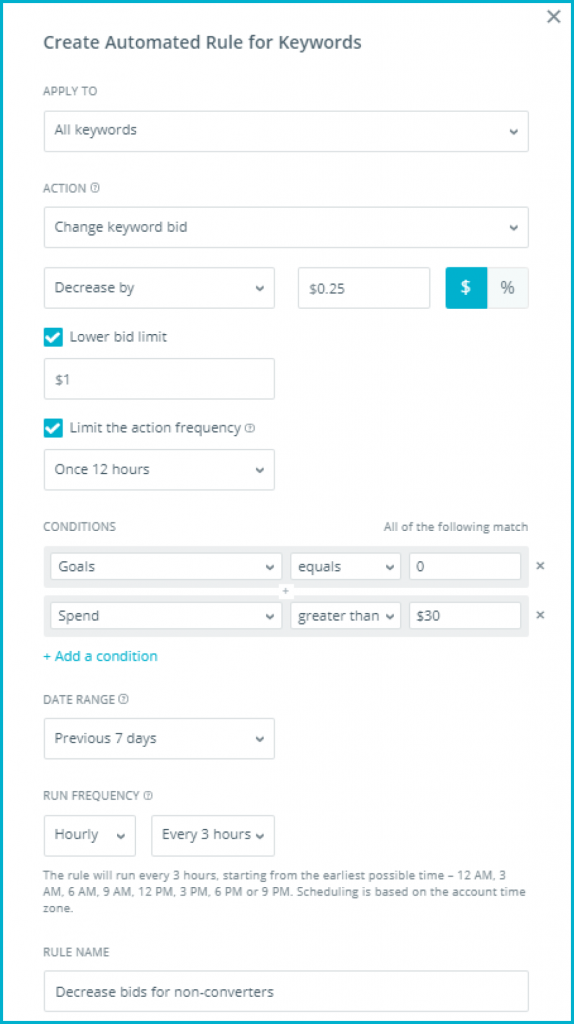
In the case when there are no conversions but we have already spent enough and know that CPA will be higher than our target cost per action, this rule will decrease a bid.
Note that the rule runs every three hours, while the bid is changed no more than twice a day (once in 12 hours).
But you cannot implement the funnel strategy without taking care about keywords that show good results – top performers.
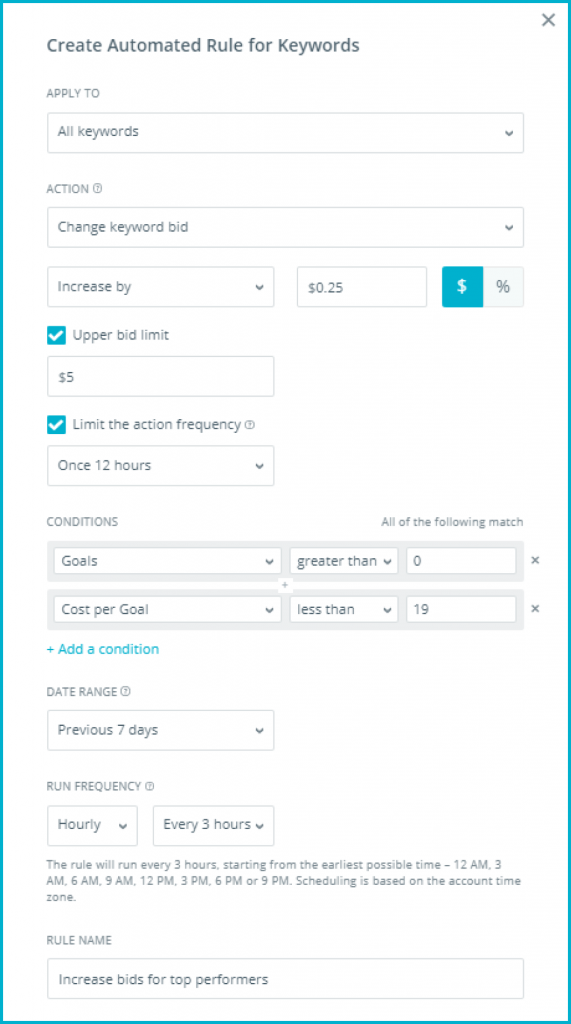
Our target CPA is $20, so Cost per Goal here equals $19, since we’re leaving the tolerance window (target CPA ±5%), as we’ve set it above in the tunnel strategy.
In the Example 1, we’ve created a rule to deal with non-converters but in some cases, when a keyword hasn’t brought any conversions over a long period of time and we’ve already spent a small fortune (e.g. a sum that is three times more than our target CPA), we should immediately pause it.
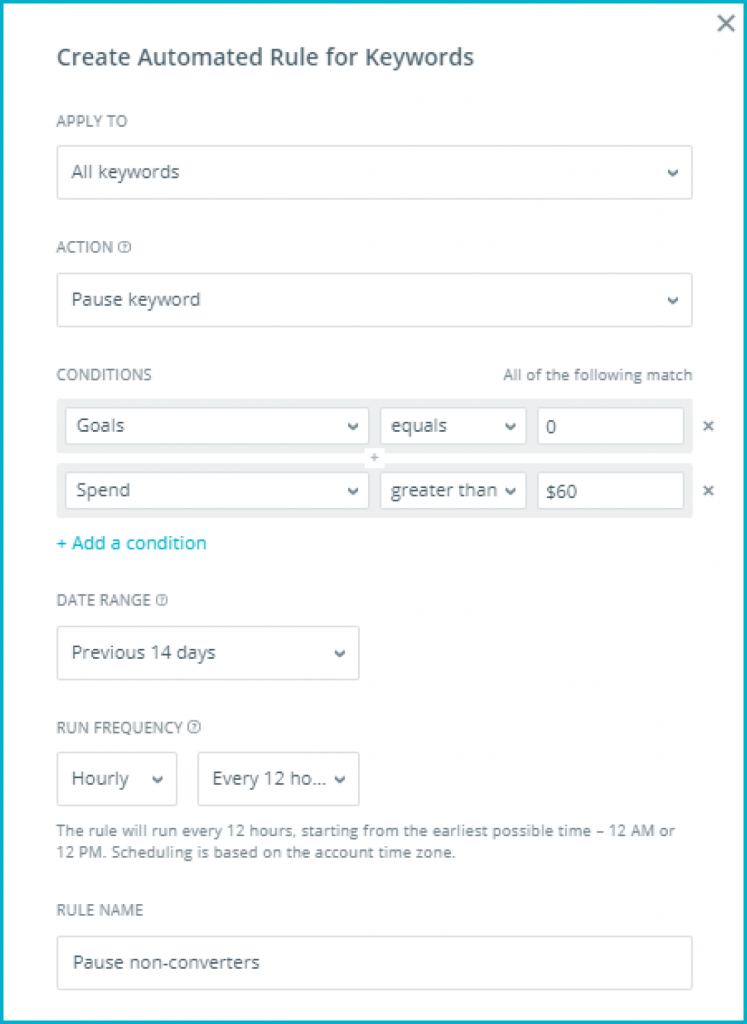
Since our target CPA, as you know, is $20, the maximum spend we can afford for a non-converter is 3 * $20 = $60. Otherwise we pause it.
Note: for keywords with a low search volume, choose a longer date range.
In some cases conversions are delayed due to various factors, like, for example, a free trial period or seasonality: holidays, events that draw widespread attention, etc. So, to not miss opportunities with keywords on pause, the rule from Example 3 should be used in tandem with a rule that will re-activate such keywords when they start to bring conversions at an acceptable cost:
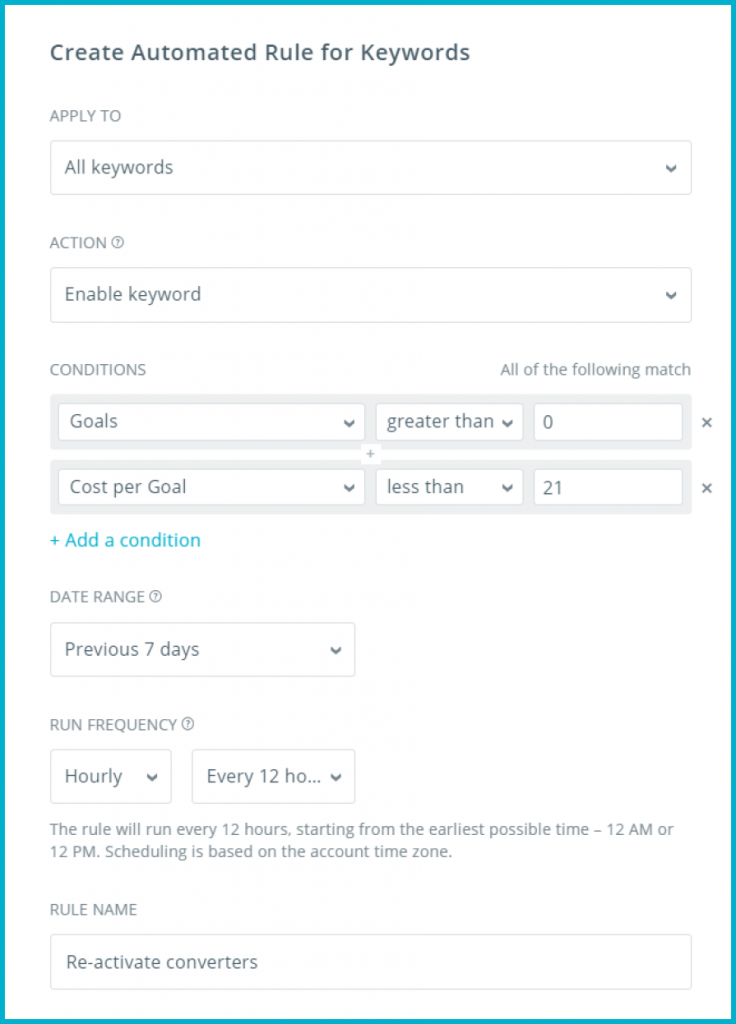
In general, to fill in the Date Range and Run Frequency fields, it would be wise to build on the user journey in your game or app and the usual time frame between the tap and conversion.
This strategy is similar to the tunnel strategy, since you will also need to specify the upper and lower bid limits. The main difference is that here you get an opportunity to automatically adjust bids to your target KPIs, whether it is cost per acquisition, cost per install, cost per goal, cost per conversion or ROAS.
Instead of tweaking Apple Search Ads campaigns and changing bids every day or even more frequently, rely on SearchAdsHQ and its automation rules. Bids will be automatically increased and decreased according to your target metrics.
As in the case with two previous strategies, you need historical data for this one as well, so avoid applying this strategy to the keywords that have no taps or spend.
Let’s assume that cost per goal is your target KPI. Create a rule in SearchAdsHQ that will adjust your keyword’s bid to the cost per goal.
According to what we have just discussed regarding historical data, let’s specify the following conditions: goals > 2, target value – cost per goal = $5, and don’t forget about the upper and lower bid limits.
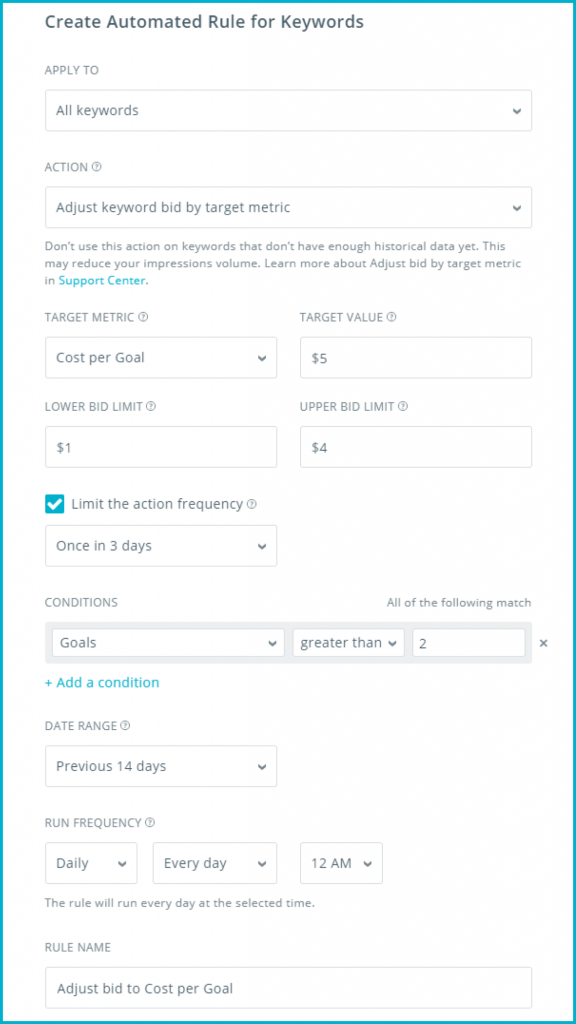
If the bid is below your lower bid limit SearchAdsHQ will automatically set the bid to the lower limit you have specified. The same applies to the case when the bid is higher than your upper bid limit – it will be replaced with the upper bid limit.
Now let’s see how this strategy works for mobile games.
Adjust a keyword bid to the optimal ROAS on the day 7:
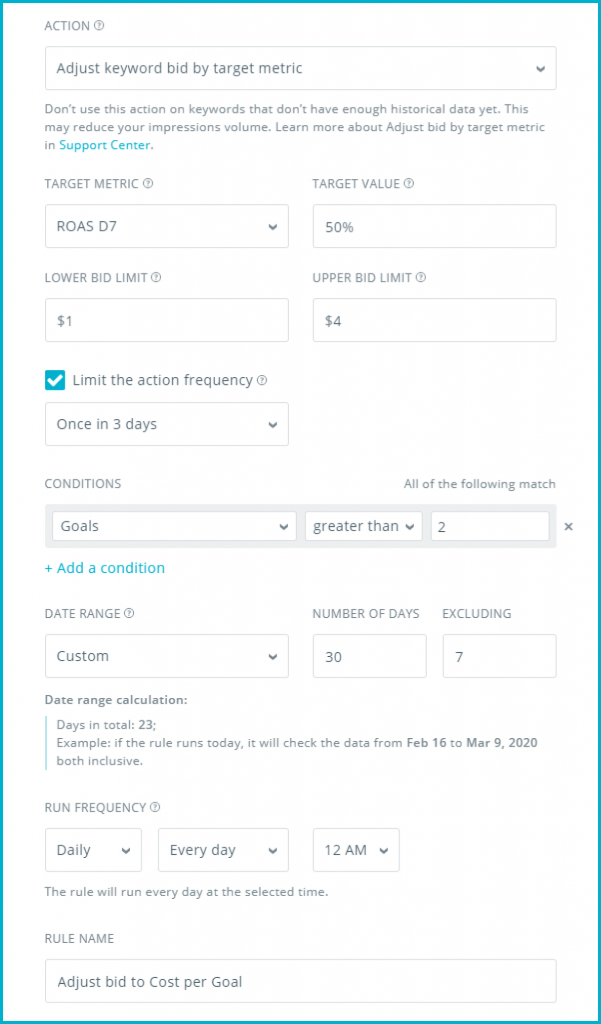
As in the case with the funnel strategy, we apply the rule to the past month whilst excluding 7 days when cohort was not fully matured yet.
If you spend loads of hours on tweaking campaigns, this strategy frees up time for you to work on scaling them. You may rest assured that keyword bids will be automatically adjusted to your target metric and that consequently Apple Search Ads will help you meet business goals for your mobile game or app.